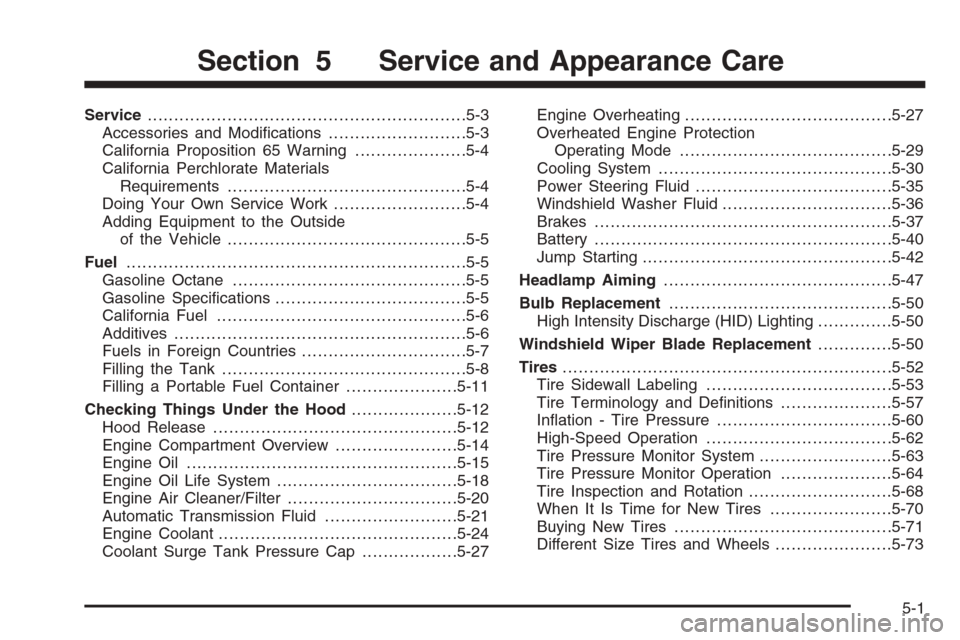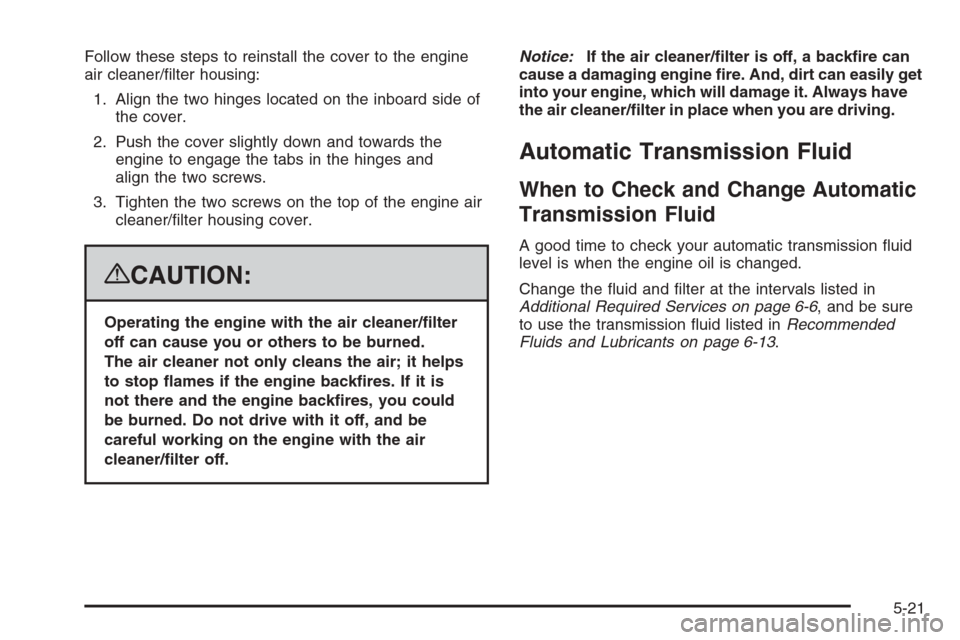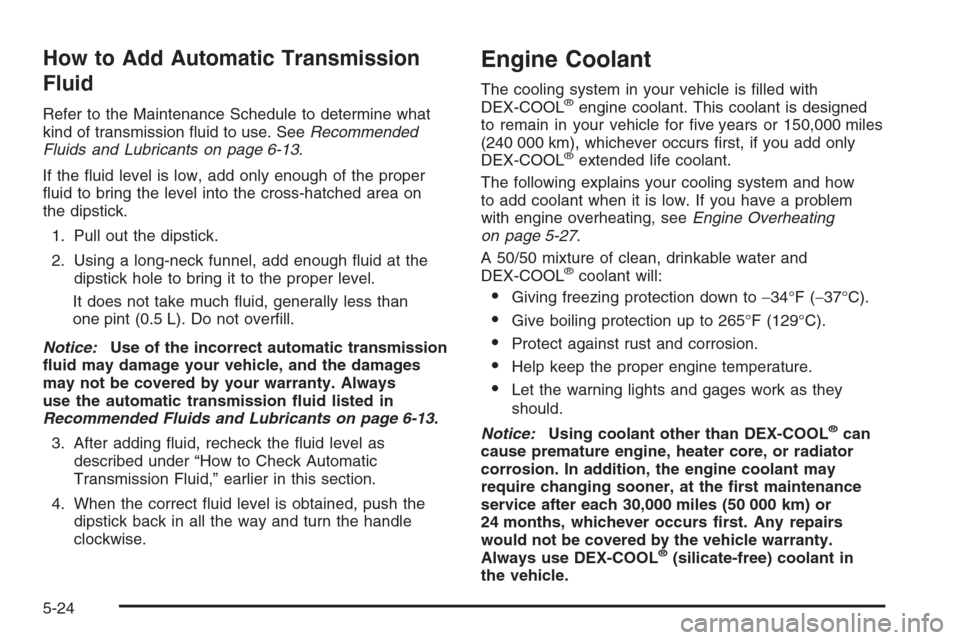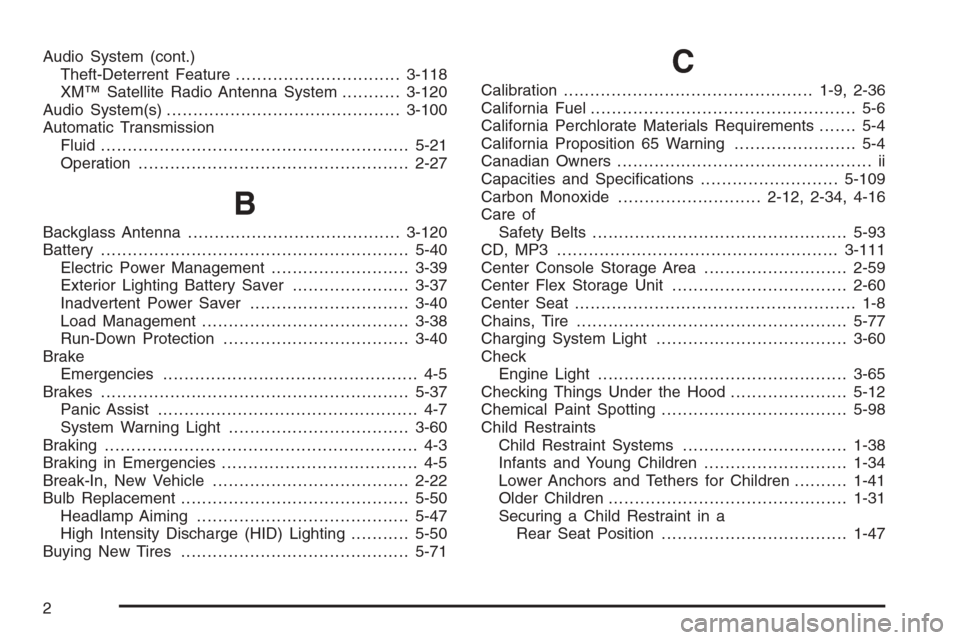check engine light CADILLAC DTS 2008 1.G User Guide
[x] Cancel search | Manufacturer: CADILLAC, Model Year: 2008, Model line: DTS, Model: CADILLAC DTS 2008 1.GPages: 454, PDF Size: 2.48 MB
Page 262 of 454

Avoid needless heavy braking. Some people drive
in spurts — heavy acceleration followed by heavy
braking — rather than keeping pace with traffic.
This is a mistake. The brakes might not have time to cool
between hard stops. The brakes will wear out much faster
if you do a lot of heavy braking. If you keep pace with the
traffic and allow realistic following distances, you will
eliminate a lot of unnecessary braking. That means better
braking and longer brake life.
If your vehicle’s engine ever stops while you are driving,
brake normally but do not pump the brakes. If you do,
the pedal could get harder to push down. If the
engine stops, you will still have some power brake
assist. But you will use it when you brake. Once the
power assist is used up, it can take longer to stop and
the brake pedal will be harder to push.
Adding non-dealer/non-retailer accessories can affect
your vehicle’s performance. SeeAccessories and
Modifications on page 5-3.Antilock Brake System (ABS)
Your vehicle has the Antilock Brake System (ABS), an
advanced electronic braking system that will help
prevent a braking skid.
When you start the engine and begin to drive away,
ABS will check itself. You might hear a momentary
motor or clicking noise while this test is going on, and
you might even notice that the brake pedal moves
a little. This is normal.
If there is a problem with
ABS, this warning light will
stay on. SeeAntilock
Brake System (ABS)
Warning Light on
page 3-61.
Let us say the road is wet and you are driving safely.
Suddenly, an animal jumps out in front of you. You slam
on the brakes and continue braking. Here is what
happens with ABS:
A computer senses that wheels are slowing down. If
one of the wheels is about to stop rolling, the computer
will separately work the brakes at each front wheel
and at both rear wheels.
4-4
Page 276 of 454

You can run the engine to keep warm, but be careful.
{CAUTION:
Snow can trap exhaust gases under your
vehicle. This can cause deadly CO (carbon
monoxide) gas to get inside. CO could
overcome you and kill you. You cannot see it
or smell it, so you might not know it is in your
vehicle. Clear away snow from around the
base of your vehicle, especially any that is
blocking the exhaust pipe. And check around
again from time to time to be sure snow does
not collect there.
Open a window just a little on the side of the
vehicle that is away from the wind. This will
help keep CO out.
Run your engine only as long as you must. This saves
fuel. When you run the engine, make it go a little faster
than just idle. That is, push the accelerator slightly. This
uses less fuel for the heat that you get and it keeps the
battery charged. You will need a well-charged battery to
restart the vehicle, and possibly for signaling later on with
the headlamps. Let the heater run for a while.
4-18
Page 293 of 454

Service............................................................5-3
Accessories and Modi�cations..........................5-3
California Proposition 65 Warning.....................5-4
California Perchlorate Materials
Requirements.............................................5-4
Doing Your Own Service Work.........................5-4
Adding Equipment to the Outside
of the Vehicle.............................................5-5
Fuel................................................................5-5
Gasoline Octane............................................5-5
Gasoline Speci�cations....................................5-5
California Fuel...............................................5-6
Additives.......................................................5-6
Fuels in Foreign Countries...............................5-7
Filling the Tank..............................................5-8
Filling a Portable Fuel Container.....................5-11
Checking Things Under the Hood....................5-12
Hood Release..............................................5-12
Engine Compartment Overview.......................5-14
Engine Oil...................................................5-15
Engine Oil Life System..................................5-18
Engine Air Cleaner/Filter................................5-20
Automatic Transmission Fluid.........................5-21
Engine Coolant.............................................5-24
Coolant Surge Tank Pressure Cap..................5-27Engine Overheating.......................................5-27
Overheated Engine Protection
Operating Mode........................................5-29
Cooling System............................................5-30
Power Steering Fluid.....................................5-35
Windshield Washer Fluid................................5-36
Brakes........................................................5-37
Battery........................................................5-40
Jump Starting...............................................5-42
Headlamp Aiming...........................................5-47
Bulb Replacement..........................................5-50
High Intensity Discharge (HID) Lighting..............5-50
Windshield Wiper Blade Replacement..............5-50
Tires..............................................................5-52
Tire Sidewall Labeling...................................5-53
Tire Terminology and De�nitions.....................5-57
In�ation - Tire Pressure.................................5-60
High-Speed Operation...................................5-62
Tire Pressure Monitor System.........................5-63
Tire Pressure Monitor Operation.....................5-64
Tire Inspection and Rotation...........................5-68
When It Is Time for New Tires.......................5-70
Buying New Tires.........................................5-71
Different Size Tires and Wheels......................5-73
Section 5 Service and Appearance Care
5-1
Page 297 of 454

Your vehicle has an airbag system. Before attempting
to do your own service work, seeServicing Your
Airbag-Equipped Vehicle on page 1-68.
You should keep a record with all parts receipts and
list the mileage and the date of any service work
you perform. SeeMaintenance Record on page 6-16.
Adding Equipment to the Outside
of the Vehicle
Things you might add to the outside of your vehicle
can affect the air�ow around it. This can cause
wind noise and can affect fuel economy and windshield
washer performance. Check with your dealer/retailer
before adding equipment to the outside of your vehicle.
Fuel
Use of the recommended fuel is an important part of the
proper maintenance of your vehicle. To help keep the
engine clean and maintain optimum vehicle performance,
we recommend the use of gasoline advertised as TOP
TIER Detergent Gasoline.
Gasoline Octane
Use premium unleaded gasoline with a posted octane
rating of 91 or higher. You can also use regular unleaded
gasoline rated at 87 octane or higher, but your vehicle’s
acceleration could be slightly reduced, and you might
notice a slight audible knocking noise, commonly referred
to as spark knock. If the octane is less than 87, you might
notice a heavy knocking noise when you drive. If this
occurs, use a gasoline rated at 87 octane or higher as
soon as possible. Otherwise, you could damage the
engine. If you are using gasoline rated at 87 octane or
higher and you hear heavy knocking, the engine needs
service.
Gasoline Speci�cations
At a minimum, gasoline should meet ASTM
speci�cation D 4814 in the United States or
CAN/CGSB-3.5 or 3.511 in Canada. Some gasolines
contain an octane-enhancing additive called
methylcyclopentadienyl manganese tricarbonyl (MMT).
We recommend against the use of gasolines
containing MMT. SeeAdditives on page 5-6
for additional information.
5-5
Page 313 of 454

Follow these steps to reinstall the cover to the engine
air cleaner/�lter housing:
1. Align the two hinges located on the inboard side of
the cover.
2. Push the cover slightly down and towards the
engine to engage the tabs in the hinges and
align the two screws.
3. Tighten the two screws on the top of the engine air
cleaner/�lter housing cover.
{CAUTION:
Operating the engine with the air cleaner/�lter
off can cause you or others to be burned.
The air cleaner not only cleans the air; it helps
to stop �ames if the engine back�res. If it is
not there and the engine back�res, you could
be burned. Do not drive with it off, and be
careful working on the engine with the air
cleaner/�lter off.Notice:If the air cleaner/�lter is off, a back�re can
cause a damaging engine �re. And, dirt can easily get
into your engine, which will damage it. Always have
the air cleaner/�lter in place when you are driving.
Automatic Transmission Fluid
When to Check and Change Automatic
Transmission Fluid
A good time to check your automatic transmission �uid
level is when the engine oil is changed.
Change the �uid and �lter at the intervals listed in
Additional Required Services on page 6-6, and be sure
to use the transmission �uid listed inRecommended
Fluids and Lubricants on page 6-13.
5-21
Page 316 of 454

How to Add Automatic Transmission
Fluid
Refer to the Maintenance Schedule to determine what
kind of transmission �uid to use. SeeRecommended
Fluids and Lubricants on page 6-13.
If the �uid level is low, add only enough of the proper
�uid to bring the level into the cross-hatched area on
the dipstick.
1. Pull out the dipstick.
2. Using a long-neck funnel, add enough �uid at the
dipstick hole to bring it to the proper level.
It does not take much �uid, generally less than
one pint (0.5 L). Do not over�ll.
Notice:Use of the incorrect automatic transmission
�uid may damage your vehicle, and the damages
may not be covered by your warranty. Always
use the automatic transmission �uid listed in
Recommended Fluids and Lubricants on page 6-13.
3. After adding �uid, recheck the �uid level as
described under “How to Check Automatic
Transmission Fluid,” earlier in this section.
4. When the correct �uid level is obtained, push the
dipstick back in all the way and turn the handle
clockwise.
Engine Coolant
The cooling system in your vehicle is �lled with
DEX-COOL®engine coolant. This coolant is designed
to remain in your vehicle for �ve years or 150,000 miles
(240 000 km), whichever occurs �rst, if you add only
DEX-COOL
®extended life coolant.
The following explains your cooling system and how
to add coolant when it is low. If you have a problem
with engine overheating, seeEngine Overheating
on page 5-27.
A 50/50 mixture of clean, drinkable water and
DEX-COOL
®coolant will:
Giving freezing protection down to−34°F (−37°C).
Give boiling protection up to 265°F (129°C).
Protect against rust and corrosion.
Help keep the proper engine temperature.
Let the warning lights and gages work as they
should.
Notice:Using coolant other than DEX-COOL
®can
cause premature engine, heater core, or radiator
corrosion. In addition, the engine coolant may
require changing sooner, at the �rst maintenance
service after each 30,000 miles (50 000 km) or
24 months, whichever occurs �rst. Any repairs
would not be covered by the vehicle warranty.
Always use DEX-COOL
®(silicate-free) coolant in
the vehicle.
5-24
Page 442 of 454

Audio System (cont.)
Theft-Deterrent Feature...............................3-118
XM™ Satellite Radio Antenna System...........3-120
Audio System(s)............................................3-100
Automatic Transmission
Fluid..........................................................5-21
Operation...................................................2-27
B
Backglass Antenna........................................3-120
Battery..........................................................5-40
Electric Power Management..........................3-39
Exterior Lighting Battery Saver......................3-37
Inadvertent Power Saver..............................3-40
Load Management.......................................3-38
Run-Down Protection...................................3-40
Brake
Emergencies................................................ 4-5
Brakes..........................................................5-37
Panic Assist................................................. 4-7
System Warning Light..................................3-60
Braking........................................................... 4-3
Braking in Emergencies..................................... 4-5
Break-In, New Vehicle.....................................2-22
Bulb Replacement...........................................5-50
Headlamp Aiming........................................5-47
High Intensity Discharge (HID) Lighting...........5-50
Buying New Tires...........................................5-71
C
Calibration...............................................1-9, 2-36
California Fuel.................................................. 5-6
California Perchlorate Materials Requirements....... 5-4
California Proposition 65 Warning....................... 5-4
Canadian Owners................................................ ii
Capacities and Speci�cations..........................5-109
Carbon Monoxide...........................2-12, 2-34, 4-16
Care of
Safety Belts................................................5-93
CD, MP3 .....................................................3-111
Center Console Storage Area...........................2-59
Center Flex Storage Unit.................................2-60
Center Seat..................................................... 1-8
Chains, Tire...................................................5-77
Charging System Light....................................3-60
Check
Engine Light...............................................3-65
Checking Things Under the Hood......................5-12
Chemical Paint Spotting...................................5-98
Child Restraints
Child Restraint Systems...............................1-38
Infants and Young Children...........................1-34
Lower Anchors and Tethers for Children..........1-41
Older Children.............................................1-31
Securing a Child Restraint in a
Rear Seat Position...................................1-47
2
Page 445 of 454

Electronic Immobilizer Operation
PASS-Key®III+...........................................2-21
Engine
Air Cleaner/Filter.........................................5-20
Check and Service Engine Soon Light............3-65
Coolant......................................................5-24
Coolant Heater............................................2-26
Coolant Temperature Gage...........................3-64
Coolant Temperature Warning Light................3-63
Drive Belt Routing.......................................6-15
Engine Compartment Overview......................5-14
Exhaust.....................................................2-34
Oil .............................................................5-15
Oil Life System...........................................5-18
Overheated Protection Operating Mode...........5-29
Overheating................................................5-27
Starting......................................................2-24
Entry Lighting.................................................3-37
Event Data Recorders.....................................7-18
Extender, Safety Belt.......................................1-30
Exterior Lamps...............................................3-32
Exterior Lighting Battery Saver..........................3-37F
Filter
Engine Air Cleaner......................................5-20
Finish Damage...............................................5-97
Flashers, Hazard Warning.................................. 3-6
Flash-to-Pass.................................................3-13
Flat Tire........................................................5-78
Flat Tire, Changing.........................................5-79
Flat Tire, Storing.............................................5-87
Floor Mats.....................................................2-60
Fluid
Automatic Transmission................................5-21
Power Steering...........................................5-35
Windshield Washer......................................5-36
Fog Lamp
Fog ...........................................................3-36
Fog Lamp Light..............................................3-68
Footwell Lamps..............................................3-38
Forward Collision Alert (FAC) System................3-10
Front Storage Area.........................................2-59
5
Page 446 of 454

Fuel............................................................... 5-5
Additives...................................................... 5-6
California Fuel.............................................. 5-6
Filling a Portable Fuel Container....................5-11
Filling the Tank............................................. 5-8
Fuels in Foreign Countries.............................. 5-7
Gage .........................................................3-69
Gasoline Octane........................................... 5-5
Gasoline Speci�cations.................................. 5-5
Running Out of...........................................2-35
Fuses
Fuses and Circuit Breakers.........................5-101
Rear Underseat Fuse Block.........................5-104
Underhood Fuse Block...............................5-101
Windshield Wiper.......................................5-100
G
Gage
Engine Coolant Temperature.........................3-64
Fuel..........................................................3-69
Speedometer..............................................3-55
Tachometer.................................................3-55
Garage Door Opener.......................................2-52
Gasoline
Octane........................................................ 5-5
Speci�cations............................................... 5-5
Glove Box.....................................................2-59
GM Mobility Reimbursement Program.................. 7-7
H
Hazard Warning Flashers................................... 3-6
Head Restraints............................................... 1-7
Headlamp
Aiming .......................................................5-47
Headlamp Wiring...........................................5-100
Headlamps
Bulb Replacement.......................................5-50
Daytime Running Lamps...............................3-35
Exterior Lamps............................................3-32
Flash-to-Pass..............................................3-13
High Intensity Discharge (HID) Lighting...........5-50
High/Low Beam Changer................................ 3-9
On Reminder..............................................3-35
Wiper Activated...........................................3-35
Heated Seats................................................... 1-3
Heated Steering Wheel..................................... 3-7
Heater...........................................................3-42
Engine Coolant...........................................2-26
Highbeam On Light.........................................3-69
High-Speed Operation, Tires.............................5-62
Highway Hypnosis...........................................4-14
Hill and Mountain Roads..................................4-15
Hood
Checking Things Under................................5-12
Release.....................................................5-12
Horn ............................................................... 3-6
How to Wear Safety Belts Properly...................1-16
6
Page 449 of 454

Message
DIC Warnings and Messages........................3-75
Mirrors
Automatic Dimming Rearview........................2-36
Manual Rearview Mirror with Compass and
Temperature.............................................. 1-9
Outside Automatic Dimming Mirror.................2-39
Outside Convex Mirror.................................2-39
Outside Heated Mirrors................................2-39
Outside Power Foldaway Mirrors....................2-38
Park Tilt .....................................................2-39
MP3 ............................................................3-111
MyGMLink.com................................................ 7-5
N
Navigation System, Privacy..............................7-19
Navigation/Radio System,
see Navigation Manual...............................3-118
New Vehicle Break-In......................................2-22
O
Odometer......................................................3-55
Off-Road Recovery..........................................4-10
Oil
Engine.......................................................5-15
Pressure Light.............................................3-67
Oil, Engine Oil Life System..............................5-18
Older Children, Restraints................................1-31
Online Owner Center........................................ 7-5
OnStar, Privacy..............................................7-19
OnStar
®System, see OnStar®Manual...............2-49
Operation, Universal Home Remote System........2-52
Other Warning Devices...................................... 3-6
Outlet Adjustment............................................3-48
Outlets
Accessory Power.........................................3-40
Outside
Automatic Dimming Mirror.............................2-39
Convex Mirror.............................................2-39
Heated Mirrors............................................2-39
Power Foldaway Mirrors...............................2-38
Overheated Engine Protection Operating Mode....5-29
Owner Checks and Services.............................. 6-9
Owners, Canadian............................................... ii
9